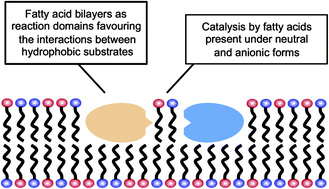Fatty acids' double role in the prebiotic formation of a hydrophobic dipeptide†
Abstract
In search of a connection between prebiotic peptide chemistry and lipid compartments, the reaction of a 5(4H)-oxazolone with leucinamide was extensively explored under buffered aqueous conditions, where diverse amphiphiles and surfactants could form supramolecular assemblies. Significant increases in yield and changes in stereoselectivity were observed when fatty acids exceeded their critical aggregation concentration, self-assembling into vesicles in particular. This effect does not take place below the fatty acid solubility limit, or when other anionic amphiphiles/surfactants are used. Data from fluorimetric and Langmuir trough assays, complementary to the main HPLC results reported here, demonstrate that the dipeptide product co-localizes with fatty acid bilayers and monolayers. Additional experiments in organic solvents suggest that acid–base catalysis operates at the water–aggregate interface, linked to the continuous proton exchange dynamics that fatty acids undergo at pH values around their effective pKa. These simple amphiphiles could therefore play a dual role as enhancers of peptide chemistry under prebiotic conditions, providing soft and hydrophobic organic domains through self-assembly and actively inducing catalysis at their interface with the aqueous environment. Our results support a systems chemistry approach to life's origin.



 Please wait while we load your content...
Please wait while we load your content...